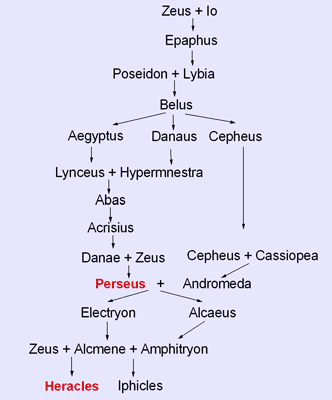
Simplified Heracles and Perseus Genealogy
In Greek Mythology, Aegyptus, or properly Aígyptos in Greek ("supine goat"), was the king of Egypt (which took its name from his, according to folk etymology; see the article Copt), the son of Belus and father of fifty sons who were all but one murdered by the fifty daughters of Aegyptus' twin brother, Danaus.
Aegyptus commanded that his sons marry the Danaides and Danaus fled to Argos, ruled by King Pelasgus. When Aegyptus and his sons arrived to take the Danaides, Danaus gave them to spare the Argives the pain of a battle. However, he instructed his daughters to kill their husbands on their wedding night. Forty-nine followed through, but one, Hypermnestra refused because her husband, Lynceus, honored her wish to remain a virgin. Danaus was angry with his disobedient daughter and threw her to the Argive courts. Aphrodite intervened and saved her. Lynceus later slew Danaus as revenge for the death of his brothers. Lynceus and Hypermnestra founded the lineage of Argive kings (the Danaan Dynasty). In some versions of the legend, the Danaides were punished in the underworld by being forced to carry water through a jug with holes, or a sieve, so that the water always leaked out.
...As you go to the citadel there is on the left of the road another tomb of the children of Aegyptus. For here are the heads apart from the bodies, which are at Lerna. For it was at Lerna that the youths were murdered, and when they were dead their wives cut off their heads, to prove to their father that they had done the dreadful deed.Pausanias 2.24.1
...By the grove in Patrae are also two sanctuaries of Serapis. In one is the tomb of Aegyptus, the son of Belus. He is said by the people of Patrae to have fled to Aroe because of the misfortunes of his children and because he shuddered at the mere name of Argos, and even more through dread of Danaus. Pausanias 7.21.13
The Aegyptus of Greek myth is not a genuinely Egyptian figure, but a figment of Egypt in the European imagination.
In the second or third century AD, Antoninus Liberalis tells of another Aegyptos, who was a young man of Thessaly. He was the companion of Neophron, but the lover of Timandra, Neophron's mother; he became the victim of Neophron's revenge, when Neophron arranged a night-time substitution, so that Aegyptos committed involuntary incest with his mother, Bules. Zeus transformed Egyptos and Neophron into eagles and Timandra into a kite. Many of the transformations in Antoninus' prose compilation are found nowhere else, and some may simply be inventions of Antoninus; this story combines several themes of Hellenistic Romance. The placement of an Aegyptus in Thessaly is inexplicable.
--------------------------------------------------------------------------------
Aegyptus is also the Latin spelling of Egypt, and the correct denomination for the Roman province.
See also : Greek Mythology. Paintings, Drawings
Retrieved from "http://en.wikipedia.org/"
All text is available under the terms of the GNU Free Documentation License
| Ancient Greece
Science, Technology , Medicine , Warfare, , Biographies , Life , Cities/Places/Maps , Arts , Literature , Philosophy ,Olympics, Mythology , History , Images Medieval Greece / Byzantine Empire Science, Technology, Arts, , Warfare , Literature, Biographies, Icons, History Modern Greece Cities, Islands, Regions, Fauna/Flora ,Biographies , History , Warfare, Science/Technology, Literature, Music , Arts , Film/Actors , Sport , Fashion --- |

